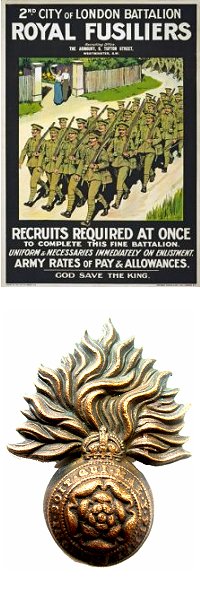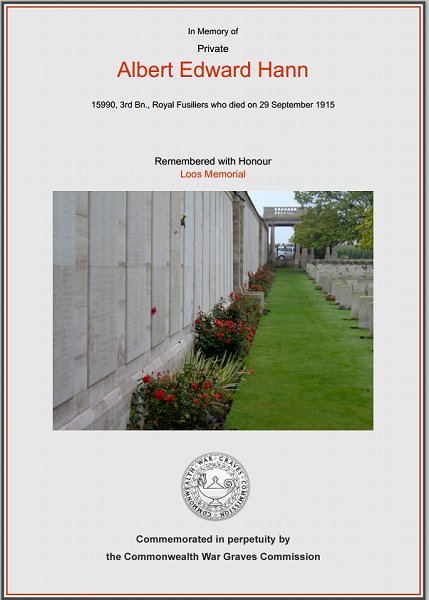yeovil at War
Albert Edward Hann
Killed in action during the Battle of Loos
 Albert Edward
Hann was born in
Yeovil in 1880,
the son of
Railway Packer
William Hann (b
1839) and Ann née
Clark (b 1841).
In the 1881
census William
and Ann were
recorded living
at
Jenning's Row
with their
children; Bessie
(b 1870), Alice
(b1873) and
one-year old
Albert. There
were also two
other Railway
Packers and two
sailors boarding
with them. It
must have been a
real squeeze
since the
buildings of
Jenning's Row
were very tiny.
Also known as
'The Colony',
Jenning’s
Buildings or New
Prospect Place,
it was a long
terrace of small
cottages, little
better than
slums and
occupied by the
very poorest
families. The
buildings were
described as
"simply huts
with no
foundations and
originally
having earth
floors".
Albert Edward
Hann was born in
Yeovil in 1880,
the son of
Railway Packer
William Hann (b
1839) and Ann née
Clark (b 1841).
In the 1881
census William
and Ann were
recorded living
at
Jenning's Row
with their
children; Bessie
(b 1870), Alice
(b1873) and
one-year old
Albert. There
were also two
other Railway
Packers and two
sailors boarding
with them. It
must have been a
real squeeze
since the
buildings of
Jenning's Row
were very tiny.
Also known as
'The Colony',
Jenning’s
Buildings or New
Prospect Place,
it was a long
terrace of small
cottages, little
better than
slums and
occupied by the
very poorest
families. The
buildings were
described as
"simply huts
with no
foundations and
originally
having earth
floors".
 By the time
of the 1891
census William
and Ann,
together with
Alice and
Albert, were
living at 5 Pen
Field. William
was now working
as a
Bricklayer's
Labourer while
11-year old
Albert was still
at school. After
he left school
Albert started
working on the
railways and in
the 1901 census
he was listed as
a Railway
Fireman and was
boarding in
Lambeth, London.
By the time
of the 1891
census William
and Ann,
together with
Alice and
Albert, were
living at 5 Pen
Field. William
was now working
as a
Bricklayer's
Labourer while
11-year old
Albert was still
at school. After
he left school
Albert started
working on the
railways and in
the 1901 census
he was listed as
a Railway
Fireman and was
boarding in
Lambeth, London.
When war was declared Albert enlisted at Hounslow, giving his residence as Taunton. He joined the 3rd Battalion, Royal Fusiliers, Service No 15990.
Also known as the City of London Regiment, the Royal Fusiliers raised no fewer than 47 battalions for service in the Great War. This makes it the fifth largest after the London Regiment, Northumberland Fusiliers, Middlesex Regiment and King's (Liverpool Regiment).
 The 3rd
Battalion was a
Regular Army
Battalion
stationed at
Lucknow, India,
in August 1914
but returned to
England in
December 1914 at
which time it
joined 85th
Brigade, 28th
Division. The
Battalion went
to France and
landed at Le
Havre
mid-January
1915. The
Division
concentrated in
the area between
Bailleul and
Hazebrouck,
being joined by
additional
Territorial
units. In 1915
they were in
action in The
Second Battle of
Ypres and The
Battle of Loos.
The 3rd
Battalion was a
Regular Army
Battalion
stationed at
Lucknow, India,
in August 1914
but returned to
England in
December 1914 at
which time it
joined 85th
Brigade, 28th
Division. The
Battalion went
to France and
landed at Le
Havre
mid-January
1915. The
Division
concentrated in
the area between
Bailleul and
Hazebrouck,
being joined by
additional
Territorial
units. In 1915
they were in
action in The
Second Battle of
Ypres and The
Battle of Loos.
The Second Battle of Ypres, 22 April-25 May 1915, was a rare German offensive on the Western Front during 1915. It was launched with two aims in mind. The first was to distract attention from the movement of German troops to the eastern front in preparation for the campaign that would lead to the victory of Gorlice-Tarnow. The second was to assess the impact of poisoned gas on the western front. Gas had already been used on the eastern front, at Bolimov (3 January 1915), but the tear gas used there had frozen in the extreme cold. At Ypres the Germans used the first lethal gas of the war, chlorine. The gas was to be released from 6,000 cylinders and would rely on the wind to blow it over the allied trenches. This method of delivery controlled the timing of the attack – the prevailing winds on the western front came from the west, so the Germans had to wait for a suitable wind from the east to launch their attack. The line around Ypres was held by French, Canadian and British troops. The attack on 22 April hit the French lines worst and, not surprisingly, the line broke under the impact of this deadly new weapon. The gas created a gap 8,000 yards long in the Allied lines north of Ypres. The success of their gas had surprised the Germans who didn’t have the reserves to quickly exploit the unexpected breakthrough, allowing enough time to plug the gap with newly arrived Canadian troops. During the battle the British, French and Canadians suffered 60,000 casualties, the Germans only 35,000.
The Battle of Loos was part of the wider Third Battle of Artois, itself part of a wider Allied attack on the German lines in the autumn of 1915. 25 September saw the start of the Second Battle of Champagne, while in Artois the French attacked Vimy Ridge. The British attack was to be launched by six divisions from Douglas Haig’s First Army and the attack was preceded by a four day bombardment that would see the first use of poisoned gas by the British. The chlorine gas would be a great disappointment. It was released at 5.50 am, giving it forty minutes to do its work before the infantry attacked at 6.30. However, much of the gas either lingered in No Man's Land or drifted back over the British lines. Despite this setback, the first British assault was a success. By the end of 25 September the British had advanced to within a thousand yards of the German second line to the north of Loos. The reserve divisions were needed to attack this intact second line of defences. However, poor communications and poor planning meant that the reserves didn’t reach the original British lines until the end of 25 September. The next afternoon the 21st and 24th Divisions launched an attack in ten columns across the open ground in front of the German second line. Largely unaffected by the four day bombardment, the barbed wire in front of this second line was intact. The British advanced to the wire, taking horrific casualties all the time, and were then forced to retreat. The battle had been so one-sided that many Germans stopped firing during the British retreat.
The battle continued for another three weeks. When the fighting finally died down, the British front line stood close to the line reached at the end of the first day, although the Germans had recaptured the Hohenzollern Redoubt. British losses at Loos were close to 50,000, with 16,000 dead and 25,000 wounded. Estimates of German casualty figures vary, but the most common figure is for a total of 25,000 losses, half the British figure. The autumn battles of 1915 all ended in a similar tale of Allied failure and heavy losses.
Albert was initially reported missing in the battle but was later reported killed in action on 29 September 1915. He was 35 years old.
On 25 February 1916 the Western Gazette reported "Private A Hann, of the 3rd Royal Fusiliers, who was reported missing in September of last year, is now stated to have been killed in action. The deceased private was a Yeovilian, but, had not been living in the town for some years, giving up employment in Essex to join the Army on the outbreak of war. His sister, Miss E Hann, resides at No 2 Victoria Buildings."
Albert is commemorated on Panels 25 to 27 of the Loos Memorial, Pas de Calais, France, and his name is recorded on the War Memorial in the Borough.
gallery

The Commonwealth War Graves Commission certificate in memory of Albert Hann.